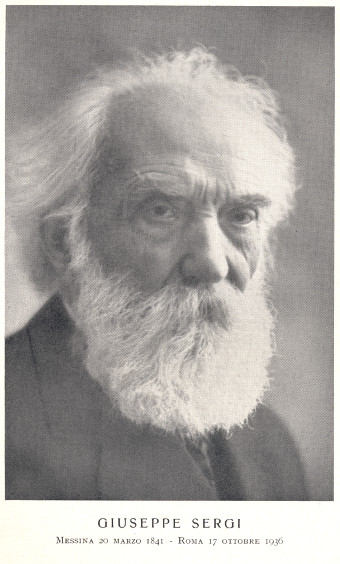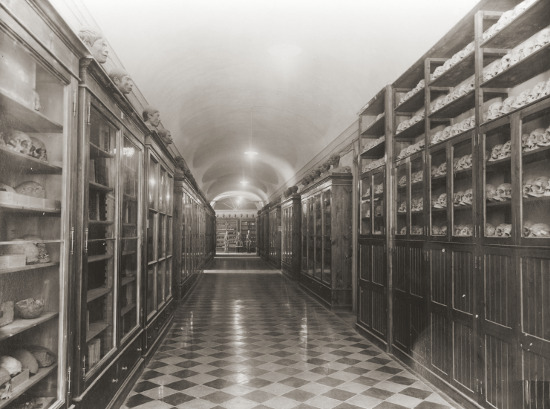Itinerary edited by SAPIENZA UNIVERSITY OF ROME 

Giuseppe Sergi (Messina 1841 – Rome 1936), an eminent Italian intellectual and scientist, was an important exponent of positivism between the 19th and 20th centuries. He had an eclectic and independent spirit - he was a fervent supporter of Garibaldi and fought in the battle of Milazzo - and had an encyclopaedic knowledge. At a young age he taught himself Greek and Sanskrit, he wrote on comparative philology and then, "enlightened" by great Greek classics, he began studying philosophy. When he was 27, he completed his first work, Usiologia ovvero scienza dell'Essenza, where he examined the philosophic concepts of ancient pre-Roman Italic populations. It was acclaimed by Mamiani and led him to teach in upper schools. Later he developed an interest in organic evolution, inspired by the success of Darwin's works of the time.
In 1873, he completed a study on physiological foundations, the first of its kind in Italy, and he made some forays in mathematics, physics, experimental psychology, anthropology (in all its aspects), and pedagogy. He was transferred from Messina to an upper school in Milan, before becoming professor of Theoretic Philosophy at the Accademia Scientifica. After a few years, he moved to Bologna, where he became one of the first professors of Anthropology after the Unification of Italy, in 1880. Four years later he was invited to teach at the Faculty of Sciences at "La Sapienza" University of Rome.




His production accounts for over four hundred written works in various fields, all underpinned by the same fundamental aim: to understand humankind and improve its life conditions. He was the first in Italy to establish an Experimental Psychology laboratory, annexed to the Institute of Anthropology. He also organised the 5th International Psychology Conference to in Rome in 1905, but he is remembered above all for setting up the Institute of Anthropology, which he enriched with a museum and progressively became more and more interesting, among the first ones in Europe for the richness and rarity of its collections. He also founded «Rivista di Antropologia» (today «Journal of Anthropological Sciences»), which was conceived as an organ of the discipline's Roman School, although it soon became the scientific periodical which followed the development of anthropological sciences in Italy.
In 1889, he published Antropologia e Scienze Antropologiche (Anthropology and Anthropological Sciences) and Le degenerazioni umane (Human Degenerations), where he emerged as a pioneer of what was called "eugenics", supported by a state-of-the-art education system. In accordance with the German school, founded by J.F. Blumenbach (1752-1840), he opposed the abuse of craniometry and proposed a "natural method" to study cranium shapes, and a classification based on standardised cranioscopic observation procedures based on various norms.
Between 1889 and 1892 he published Educazione ed Istruzione, where he studied a collection of four hundred craniums from Melanesia; in 1893, he published La classificazione delle specie umane secondo il metodo naturale (The classification of human species according to the natural method). In 1916, he founded the «Rivista Italiana di Sociologia» (Italian Magazine of Sociology).
His students included his son Sergio, Maria Montessori and Fabio Frassetto. He died in Rome in 1936, shortly before his hundredth birthday. He was still remarkably lucid when he drew up a sort of spiritual and scientific testament. Here follows a brief extract:
This is the last vision regarding the science of mankind, because I have reached the end of the 94th year of my life and I have lived long enough to often rectify my judgements in a continuous series of observations on the old and the new, according to the occasion.
The first old ideas are dismissed, they are replaced with new and unexpected visions of the facts which are presented; judgements fade away like shadows into the darkness, new spontaneous and insistent ones arrive and replace previous ones; vision becomes telescopic, with a broadened and deeper field of vision: everything is spontaneous and not voluntary, nor pondered for too long, arising suddenly from that deep unconscious which we call the mind.

1841 he was born in Messina on 21st March
1868 he published Usiologia, ovvero scienza dell’Essenza. He began teaching Philosophy in upper schools in Messina and then Milan.
1873 he published the first part of his Principi di Psicologia: opuscolo ad uso delle scuole (Principles of Psychology: a booklet for schools), where he already turned out to be a forerunner of experimental psychology.
1879 he taught Theoretic Philosophy at the Accademia Scientifico Letteraria of Milan; he published Elementi di Psicologia, (Elements of Psychology), a work translated into French and other languages, in which he combined psychology and natural history of humanity.
1880-1884 Professor of Anthropology at the University of Bologna.
1884 he was invited to join "La Sapienza" University of Rome, where he organises the activities of the Chair of Anthropology. Five years later it was officially named Institute of Anthropology and Experimental Psychology, with annexed museum.
1889 he published Antropologia e Scienze Antropologiche (Anthropology and Anthropological Sciences) and Le degenerazioni umane (Human Degenerations), where he emerges as a pioneer of “eugenics”.
1893 he published La classificazione delle specie umane secondo il metodo naturale (The classification of human species according to the natural method) and founded Societą Romana di Antropologia.
1894-1898 he published works on psychology and Italian prehistory, where he claimed that Italians originate from Africa.
1905 thanks to his popularity and international acclaim of his psychological works, he chaired the 5th International Psychology Congress, which was organised for the first time in Rome, after the previous editions in Paris, London and Berlin.
1916 he founded «Rivista Italiana di Sociologia» and resigned as professor of anthropology from the University of Rome.
1917-1935 he continued his literary production and developed an interest in the evolution of living organisms and the origins of life.
1936 he died in Rome on 17th October.
 Milan
Milan  Bologna
Bologna  Rome
Rome  Sardinia
Sardinia  Vienna
Vienna  Paris
Paris  Berlin
BerlinBattaglia R. (1939). Necrologio di Giuseppe Sergi. Bollettino della Soc. Adriatica di Scienze Naturali, vol. XXXVII, pp. 22-28.
Correnti V. (1980-81). L’antropologia fisica in Italia. Rivista di Antropologia, vol. LXI, pp. 21-40.
Correnti V.(1984-85). Il cammino dell’antropologia italiana. Sintesi storica. Rivista di Antropologia, vol. LXIII, pp. 309-316.
Correnti V. (1984-85). L’Istituto di Antropologia dell’Universitą di Roma “La Sapienza”. Origini, vicende, attivitą. Rivista di Antropologia, vol. LXIII, pp. 323-338.
Cresta M., Destro-Bisol G., Manzi G. (1993). Cent’anni di Antropologia a Roma. Celebrazioni per il centenario dell’Istittuto Italiano di Antropologia. Rivista di Antropologia, vol. LXXI, pp. 1-30.
Landra G. (1937). Necrologio di Giuseppe Sergi. Rivista di Biologia, vol. XXII, Fasc. II, pp. 1-11.
Manzi G. (1987). Il Museo di Antropologia dell'Universitą di Roma "La Sapienza": una testimonianza del percorso intellettuale di Giuseppe Sergi nella seconda metą del XIX secolo. In G. Mucciarelli (a cura di), Giuseppe Sergi nella Storia della Psicologia e dell'Antropologia in Italia; pp. 127-137. Pitagora, Bologna.
Sergi S. (1937). In memoria di Giuseppe Sergi. Rivista di Antropologia, vol. XXXI, pp. 1-35.
Spedini G. (1982-83). Prospettive e finalitą nel processo di rinnovamento dell’antropologia. Rivista di Antropologia, vol. LXII, pp.327-332.
Tucci G., Blanc G.A., Pettazzoni R., Niceforo A., Montesano G., Corso R., Businco L., Sergi S. (1937). In memoria di Giuseppe Sergi. Discorsi pronunciati alla Societą Romana di Antropologia nella Adunanza del 22 Maggio 1937. Rivista di Antropologia, vol. XXXI, pp. 39-55.